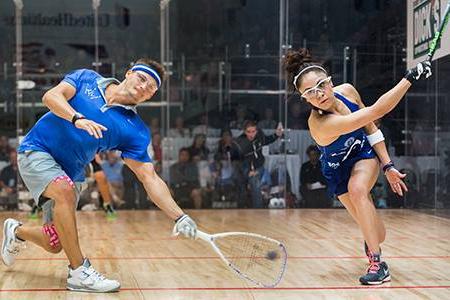Racquetball: An Exciting Sport Worth Watching and Playing

Imagine two gladiators inside of a closed room with their battle gear ready. Then, with incredible speed and force, a ball is struck at a velocity in excess of 100 to 150 mph toward someone ready to retrieve the serve with only seconds to respond to prevent the opponent from scoring a point. As the rally continues, the warriors navigate the small enclosure while exerting considerable speed, balance, strength, and mental fortitude. This game is racquetball: an exciting sport worth watching and playing!
​Some might suggest that racquetball is a game that had its day during the 80’s, as it might be described by some as an ancient sport. However, this isn’t the case. Racquetball is alive, well, and played around the world. In recent years, racquetball has begun its reemergence as a recognized sport. “Racquetball participation is making steady progress after a slightly flat period, our numbers are up in every measureable area: recreational players, tournament players, indoor, and outdoor”, according to Bob Bodor, Manager, Member Services USA Racquetball.
Many don’t realize the compelling reasons to play racquetball — it can be played by individuals of any age, size, ability, flexibility, or strength because racquetball is a/an: fun, aerobic, competitive, strategic, and family friendly sport. Bob highlighted that, “Regardless your ability, there is no better combination of fitness and competition available in the industry and you get this with less than an hour of time commitment”.
​Racquetball is played on a court 40 feet long x 20 feet wide x 20 feet high. At the amateur level, each match is played to the best of three games. The first two games are played to 15 points with a tiebreak game – if necessary – to 11 points with all games needing to be won by a point. The objective of this game is for a server to put the ball into play by hitting the front wall and sending the ball beyond the service line that is marked on the court. As long as the ball doesn’t hit the floor, the ceiling, or more than two walls prior to crossing this line, it’s a good serve. Then, the receiver must return the ball to the front wall without the ball hitting the floor more than once to keep the rally going. There are additional rules (www.teamusa.org/USA-Racquetball/How-To-Play/Rules), but this information provides the basics for anyone to start playing.
At the professional level, there are men’s (www.irt-tour.com) and women’s (www.lprtour.com) organizations. Each of these tours highlights the greatest players and ambassadors of this sport. In recent years, the top players on each tour have had streaks that aren’t realized in many sports. For example, Kane Waselenchuk (Canada) is arguably the most dominant male player of any sport after winning an incredible 10th U.S. Open Racquetball Championship this past October in Minneapolis, MN and only having a handful of losses in many years. Another dominant force is Paola Longoria (Mexico) who has become a powerhouse in the women’s game with a winning record of five U.S. Open Championships with only a single loss in the last three years. These players demonstrate performance, agility, grace, and dominance that many competitors would love to emulate.
​In addition to the professional tours, there are various levels of racquetball competition: playing at neighborhood clubs, local tournaments, collegiate teams, and also junior and adult national teams. The U.S. Junior and Adult Teams represent the U.S. in international competition, which include tournaments offered by the International Racquetball Federation and the Pan American Racquetball Confederation. These various competitions demonstrate the sustainability of racquetball not only in the U.S. but internationally also. Moreover, racquetball continues to be popular and to experience worldwide growth — especially in North America, South America, and Asia. For example, players from Bolivia, Colombia, Costa Rica, and Guatemala have had significant success recently in international competition.
If you seek to get into better shape, lose weight, and/or improve your overall fitness while having fun also, then racquetball is the game for you. If you want to watch a sport that moves at a fast pace, requires quick reflexes, and is a strategic game that’s played with the excitement of X Games, then you won’t be disappointed watching this dynamic and energetic sport. Bob stressed, “You just can’t beat the fitness value you get on a racquetball court in any other physical activity.
“​Welcome to racquetball — a game governed in the U.S. by USA Racquetball (www.teamusa.org/USA-Racquetball) and internationally by the International Racquetball Federation (www.internationalracquetball.com).
Special thanks to Ken Fife, photographer at The Stylish Shutter Portrait Studio (www.stylishshutter.com) and Doug Ganim, tournament director for the UnitedHealthcare U.S. Open Racquetball Championships (www.unitedhealthcareusopen.com) for the picture used with this article.
